What is inside a power transformer?
What is inside a power transformer? As a core device for energy conversion and transmission in power systems, the performance, efficiency, and service life of a transformer directly depend on the selection of main materials and structural design.
From energy conversion in the magnetic circuit to current conduction in the circuit, from safety protection by insulation to stable support by structures, the characteristics of each material profoundly affect the operational performance of the transformer.
This article will comprehensively dissect the core materials and structural details of the transformer main body, helping industry professionals and power practitioners gain an in-depth understanding of its working principles and selection logic.
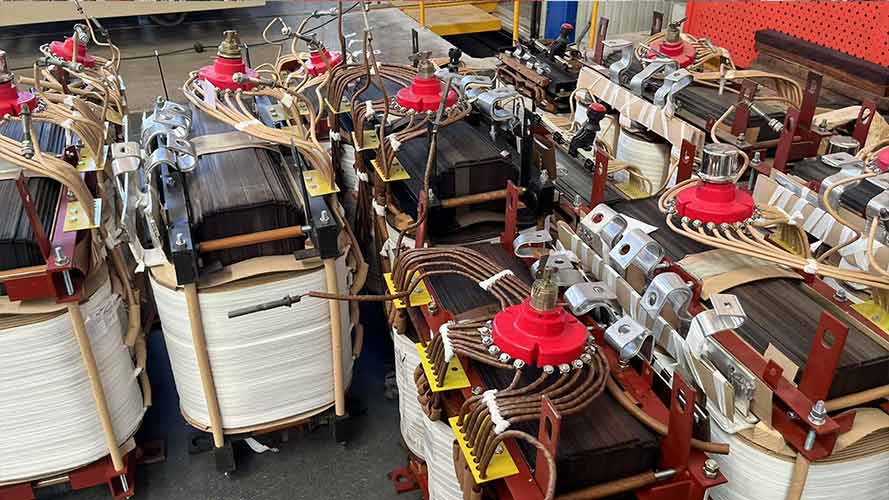
Magnetic Circuit Materials: The “Heart” of Transformer Energy Conversion
The magnetic circuit is the core link for a transformer to achieve electromagnetic induction. The magnetic properties of its materials directly determine no-load loss, volume, and energy efficiency. Currently, mainstream magnetic circuit materials include silicon steel sheets and amorphous alloy cores, each with its own focus in performance, craftsmanship, and application scenarios.
1. Silicon Steel Sheets: The “Performance Leader” Among Traditional Magnetic Circuit Materials
Silicon steel sheets (also known as electrical steel) are the mainstream material for transformer cores. Their core role is to achieve efficient conduction of magnetic flux through high magnetic permeability while reducing iron loss (hysteresis loss and eddy current loss). The performance requirements for silicon steel sheets focus on three core indicators: low iron loss, high magnetic induction, and good processability.
- Low iron loss: Iron loss is the main source of transformer no-load loss. The lower the iron loss, the more energy-efficient the transformer operation. Countries classify grades based on iron loss values. For example, China’s 30Q120 silicon steel sheet has an iron loss value (P17/50) ≤ 1.20W/kg, suitable for high-efficiency transformers.
- High magnetic induction: High magnetic induction intensity (such as B800A) under a strong magnetic field can reduce the core volume and save materials. For instance, the B800A of ordinary cold-rolled grain-oriented silicon steel sheets (CGO) is 1.78~1.85T, while that of high-magnetic-permeability silicon steel sheets (Hi-B steel) can reach above 1.85T, reducing core weight by approximately 10%-15%.
- Good processability: Silicon steel sheets with smooth surfaces, uniform thickness, and good punchability can improve the core filling factor. Typically, high-quality silicon steel sheets have a filling factor of over 0.97, reducing losses caused by magnetic circuit gaps.
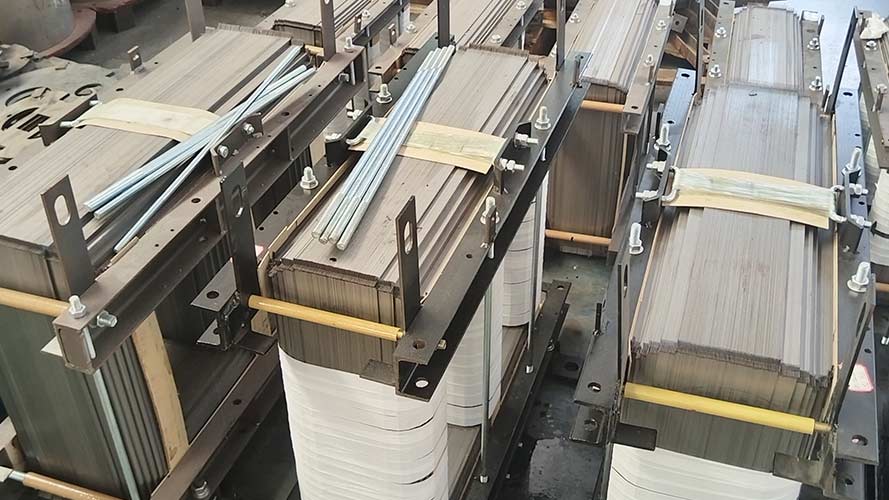
Classification and Application Scenarios of Silicon Steel Sheets
According to performance and processing technology, silicon steel sheets can be divided into three categories, suitable for transformer energy efficiency requirements:
- Ordinary cold-rolled grain-oriented silicon steel sheets (CGO): Suitable for transformers with medium and low voltage and moderate energy efficiency requirements (such as 35kV and below distribution transformers). The deviation of grain orientation from the rolling direction is about 7°, B800A is approximately 1.80T, with moderate iron loss and relatively low cost.
- High-magnetic-permeability silicon steel sheets (Hi-B steel): The Gaussian orientation texture degree is significantly improved through a secondary recrystallization process, with a grain orientation deviation of only 3° from the rolling direction. B800A can reach above 1.88T, and iron loss is 20%-30% lower than that of CGO. It is suitable for high-voltage transformers (110kV and above) or high-efficiency distribution transformers.
- Laser-scribed silicon steel sheets: Based on Hi-B steel, laser beam irradiation technology is used to generate micro-strain on the surface, further refining the magnetic axis, and reducing iron loss by 5%-10% compared with Hi-B steel. However, annealing treatment should be avoided (high temperature will eliminate the laser treatment effect), and it is mostly used in scenarios with extremely high requirements for no-load loss (such as new energy power station supporting transformers).
2. Amorphous Alloy Cores: The “New Force” in Energy-Saving Transformers
Amorphous alloy is a new type of soft magnetic material developed in the 1970s. It forms a thin strip (0.02-0.03mm thick) through ultra-rapid cooling technology (cooling rate up to 10⁶℃/s) with a non-crystalline structure. Its hysteresis loss is only 20%-30% of that of silicon steel sheets, making it the most energy-efficient magnetic circuit material currently.
Core Advantages
- Extreme energy saving: Transformers using amorphous alloy cores have no-load loss reduced by 70%-80% and no-load current reduced by more than 50% compared with silicon steel sheet transformers. Taking a 1000kVA distribution transformer as an example, annual electricity savings can reach thousands of degrees, especially suitable for grid distribution transformers that operate for a long time.
- Simplified craftsmanship:As a non-oriented material, it can adopt a direct seam structure, making the core manufacturing process simpler; however, due to material characteristics, it can only be made into a wound core (cannot be laminated) and needs to be purchased as a whole.
Application Limitations and Breakthrough Directions
Despite significant energy-saving advantages, amorphous alloy cores still have some problems to be solved:
- Low saturation magnetic induction: The saturation magnetic induction is about 1.56T (1.9T for silicon steel sheets), and the design magnetic induction needs to be reduced by 20% (oil-immersed transformers ≤ 1.35T, dry-type transformers ≤ 1.2T), resulting in a slightly larger core volume.
- Stress sensitivity: The no-load performance of the strip is prone to deterioration after being stressed, so a suspended structure (only subject to its own gravity) should be adopted, and tapping is strictly prohibited during assembly.
- Difficulty in noise control: Magnetostriction is 10% larger than that of silicon steel sheets, so it is necessary to control noise by reducing the design magnetic induction (such as design magnetic induction ≤ 1.2T in sensitive areas) to meet the sound level requirements of the power grid for sensitive areas.
- Domestic progress: At present, domestic companies such as Advanced Technology & Materials Co., Ltd. and Qingdao Yunlu have achieved mass production of 213mm, 170mm, and other wide strips, with performance gradually approaching imported Hitachi Metals products, and cost advantages are becoming increasingly prominent.
Circuit Materials: The “Vessels” for Current Conduction
The core of a transformer’s circuit is the winding (coil). The selection of its conductor material directly affects conduction efficiency, short-circuit withstand capacity, and cost. Currently, the mainstream materials are copper and aluminum, each with its own focus in performance and application scenarios.
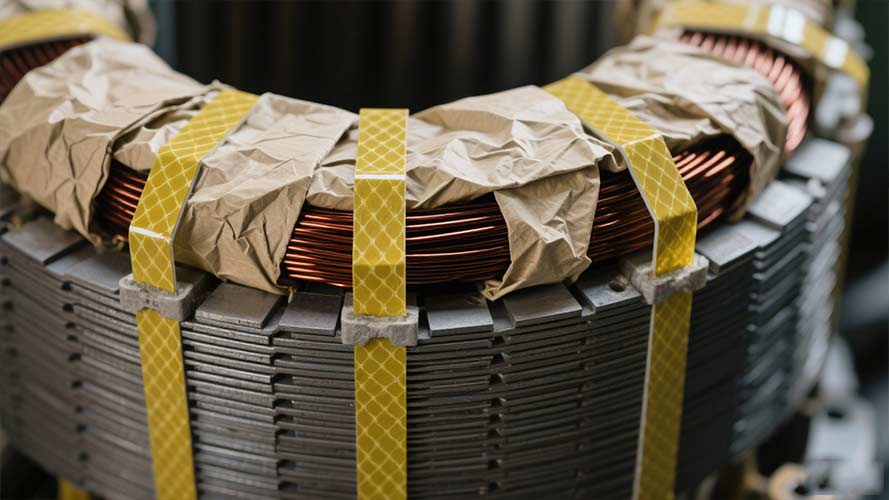
Performance Comparison and Selection Logic of Copper and Aluminum
Characteristics | Copper Conductor | Aluminum Conductor |
Resistivity | Low (≈1.72×10⁻⁸Ω·m) | Higher (≈2.82×10⁻⁸Ω·m) |
Density | 8.96g/cm³ | 2.7g/cm³ (only 30% of copper) |
Short-circuit temperature rise limit | 350℃ | 250℃ |
Mechanical strength | High (stress limit 1600kg/cm²) | Low (stress limit 450kg/cm²) |
Weldability | Easy to weld | Welding quality is difficult to guarantee |
- Copper conductors: Suitable for scenarios with high requirements for reliability and short-circuit withstand capacity (such as amorphous alloy transformers, high-voltage and large-capacity transformers). Although the cost is high (about 60,000 yuan/ton), the low resistivity can reduce load loss, and the mechanical strength is high, with short-circuit resistance more than 3 times that of aluminum.
- Aluminum conductors: With low density (only 30% of copper), transformers are lighter, and surface burrs are easy to eliminate, reducing the risk of inter-turn short circuits. However, a larger cross-sectional area is required (60% larger than copper under the same loss), and the volume is slightly larger, mostly used in 35kV and below small and medium capacity transformers (such as rural power grid distribution transformers).
Insulating Materials: The “Shield” for Safe Operation
The insulation system of a transformer is the core to ensure the service life and reliability of the equipment, and it needs to meet multiple functions such as electrical isolation, heat dissipation, and mechanical support. According to the form, it can be divided into gas, liquid, and solid types, suitable for transformers of different structures (oil-immersed/dry-type).
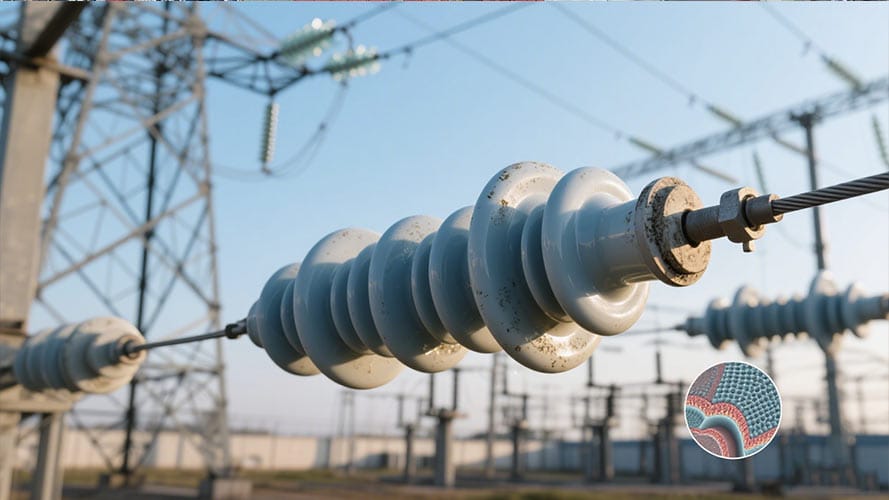
1. Liquid Insulating Materials: The “Blood” of Oil-Immersed Transformers
Insulating oil is the core insulation and cooling medium of oil-immersed transformers, which needs to have characteristics such as high electrical strength (breakdown field strength ≥ 30kV/mm), low viscosity (good fluidity), and high flash point (≥ 140℃).
- Mineral oil: The most commonly used insulating oil, refined from petroleum fractions, with low cost and stable performance, suitable for most oil-immersed transformers (10kV-1000kV).
- Synthetic ester: An environmentally friendly alternative material with a high ignition point (≥ 300℃) and a biodegradation rate ≥ 90%, suitable for scenarios with high fire protection requirements (such as high-rise buildings, subway supporting transformers).
- Vegetable insulating oil: Made from rapeseed oil and soybean oil, it has outstanding environmental protection, but low-temperature fluidity needs to be improved. It is currently mostly used in 10kV distribution transformer pilots.
2. Solid Insulating Materials: The “Skeleton” of Dry-Type Transformers
Dry-type transformers have no insulating oil and rely on solid materials for insulation and support. The core materials include epoxy resin, insulating paper, and composite materials.
- Epoxy resin: Class F insulation (long-term temperature resistance 155℃) with excellent electrical insulation performance (breakdown field strength ≥ 16MV/m). It is formed by casting or impregnation and is the core of dry-type transformer coil insulation. Attention should be paid to avoiding curing defects (such as bubbles and cracks), otherwise, partial discharge is likely to occur, affecting service life.
- Insulating paper and cardboard: Made of sulfate wood pulp, cable paper (for inter-turn/interlayer insulation), crepe paper (for lead insulation), and insulating cardboard (for spacers and struts) are basic insulating materials for oil-immersed and dry-type transformers. After oil impregnation, the electrical strength of cable paper can be increased from 6-9kV/mm in air to 70- 90kV/mm.
- Electrical composite materials: DMD (polyester film + polyester fiber cloth) is suitable for interlayer insulation of class F dry-type transformers; NHN (polyimide film + aramid paper) has a temperature resistance of class H (180℃) and is the preferred insulating material for new energy dry-type transformers.
3. Gaseous Insulating Materials: “Supplements” for Special Scenarios
- Air: The default insulating medium for dry-type transformers, with low cost but limited electrical strength (breakdown field strength 3kV/mm), which needs to be used with solid insulating materials.
- Sulfur hexafluoride (SF₆): Its electrical strength is 2.5 times that of air, and it has good arc-extinguishing properties, mostly used in fully enclosed combined electrical equipment (GIS) and some special transformers (such as railway traction transformers).
Structural Materials and Accessories: The “Skeleton” and “Nerves” for Stable Operation
The structural materials of a transformer are responsible for support, encapsulation, and protection, while accessories realize performance monitoring and protection, both of which jointly ensure the stable operation of the equipment.
1. Structural Materials: Bearing and Protection
- Steel: Oil tanks, clamps, radiators, etc., mainly use Q235 steel, which has high strength and low cost; non-magnetic steel (such as 45Mn17Al3) is used at the outlet bushing of the oil tank to reduce eddy current loss.
- Laminated products: Epoxy glass cloth boards (for struts and clamp insulation) and phenolic laminated cardboard (for oil-immersed transformer insulation parts) have both insulation and mechanical strength.
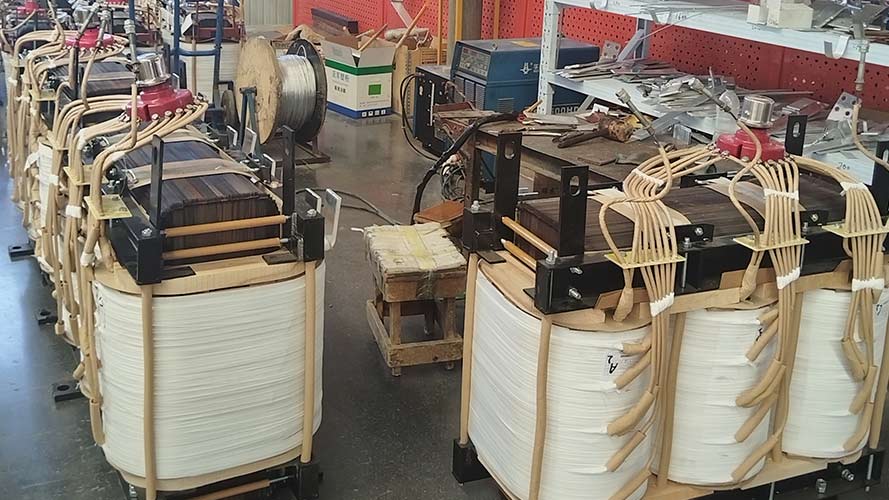
2. Core Accessories: Monitoring and Protection
- Oil-immersed transformer accessories: Gas relays (monitoring gas production from internal faults), pressure relief valves (pressure relief during overpressure), tap changers (voltage regulation), and temperature controllers (oil temperature monitoring).
- Dry-type transformer accessories: Temperature controllers (linked with fan heat dissipation), zero-sequence current transformers (leakage monitoring), and enclosures (protection and heat dissipation).
Conclusion: Material Selection Determines Transformer “Personality”
The performance of a transformer is essentially a comprehensive reflection of material characteristics: silicon steel sheets and amorphous alloy cores determine energy efficiency, copper and aluminum affect loss and cost, and insulating materials determine service life and applicable scenarios.
With the development of new energy and UHV fields, new materials (such as high magnetic induction silicon steel, environmentally friendly insulating oil, and domestic amorphous alloys) will continue to promote transformers to be “more energy-efficient, more reliable, and more environmentally friendly”.
In selection, it is necessary to comprehensively consider the application scenario (power system/transportation/industry/new energy), capacity level, and energy efficiency standards to achieve the optimal balance between performance and cost.
